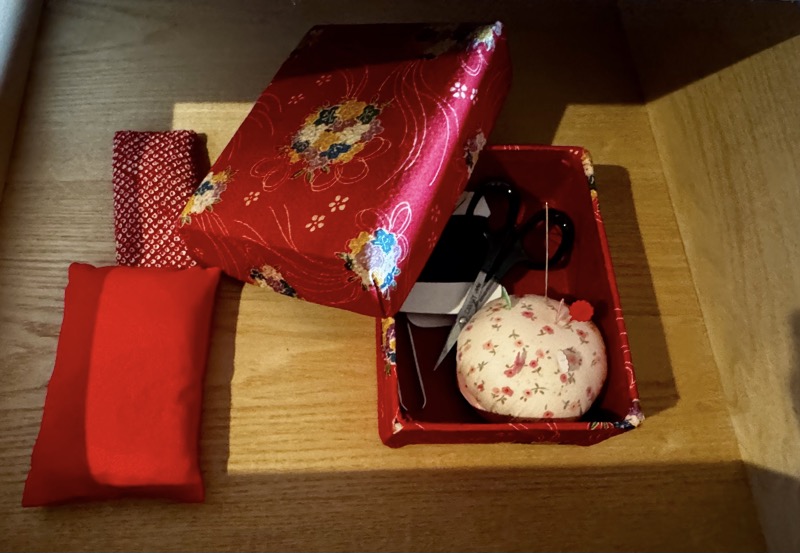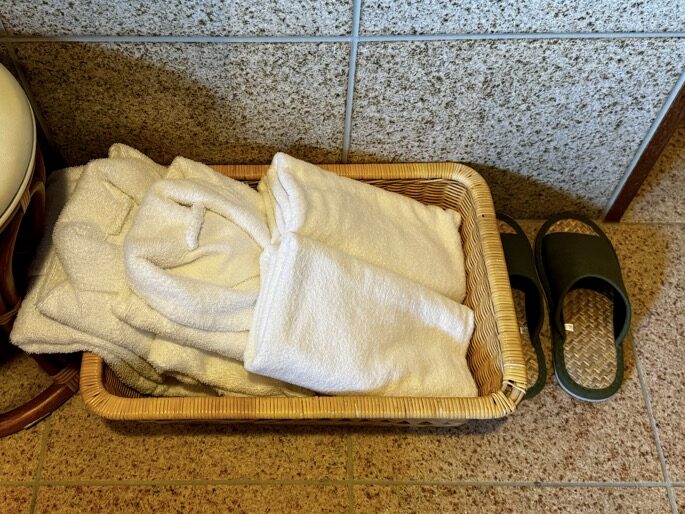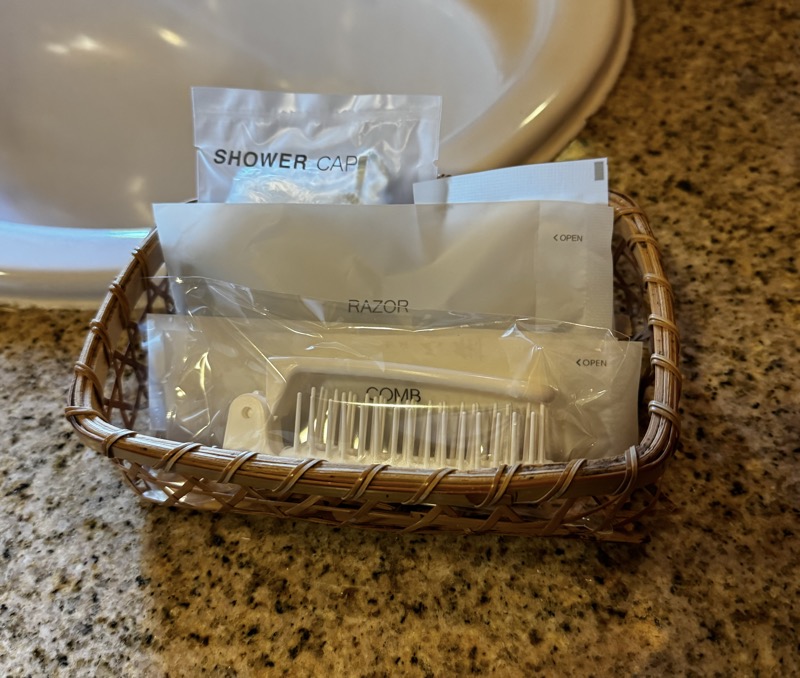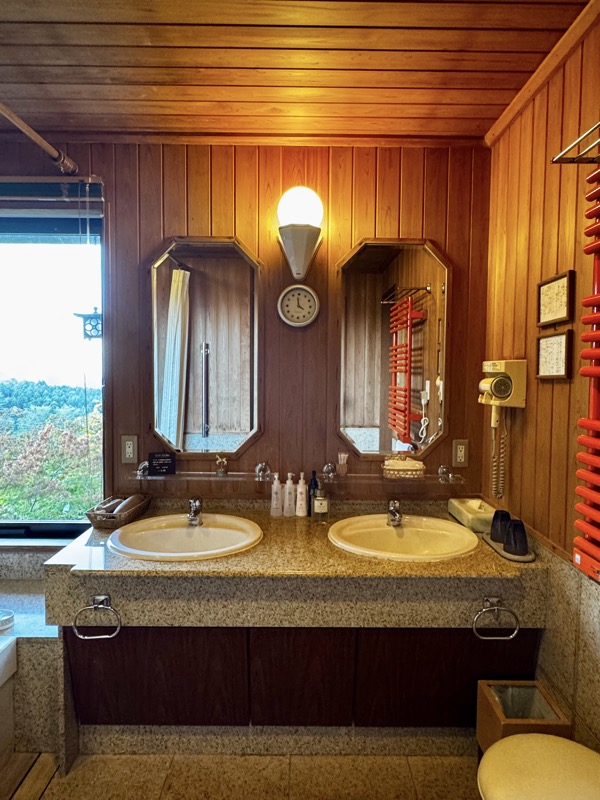We decided to spend three nights in Ikaho, which it turns out is practically unheard of… no one comes to Ikaho for three nights. Foreigners in particular very rarely come to Ikaho at all let alone stay three nights, (we saw only two other western tourists the entire three days we were there), but even the Japanese tourists who come to visit Ikaho never come and stay three nights in Ikaho apparently!
However, we had work to do and so we planned for a three night stay. Only problem was – it was seriously near impossible to find a place with three consecutive nights accomodation available, so I ended up choosing one ryokan and booking one night in one type of room and two nights in another. It might have been different if I could read or speak Japanese, which might have meant I could have contacted establishments directly a little easier, but using their (all Japanese and not easy to translate, websites) or trying affiliate sites like the dreaded booking dot com or Agoda or Japanican … it worked out easier to book direct and just suck it up that we would be changing rooms.
It ultimately worked out really well. The staff at Oyado Tamaki were so so wonderfully attentive because we were staying for three nights! It was quite a big deal for them to have us stay so long… it was actually really cute. The landlady in particular was especially friendly, welcoming and appreciative.


Oyado Tamaki is a wonderful blend of traditional Japanese ryokan with Western comfort, without going overboard with the Western elements so as to lose the Japanese culture that you come fro in the first place. There was a lovely comfortable lobby and bar area where we were welcomed with yuzu tea and a snack. Again, the Japanese love of viewing/engaging with nature was evident in the design of these public spaces as the lounge seating is arranged with large picture windows to overlook a gorgeous Japanese garden.



Our first night was in a ‘Horai’ Western style room with a cypress indoor bath.

The room genkan was a spacious and welcoming space where you could put all your luggage… as is rapidly becoming the norm, we left our shoes at the genkan to the ryokan, where we were given slippers to wear around the ryokan, where we arrived at the room to find other slippers to wear in our room, and I bet there are different slippers for the toilet too!


His and hers… quite often though, ‘His’ won’t fit Western men with large feet!

Our room was a very tastefully decorated space with an incredibly high ceiling and views over the base of the famous Ikaho Stone Steps.


It had a comfortable sitting area where we could see the sunrise/sunset and this turned into a nice spot to work.

Welcome snacks… local Gunma mochi and some barley crackers.


The ceiling in this rooms was impressive, it must have been 16’ high, and with it’s timber spokes and fabric-like design, felt oddly Turkish…?

Mr K always appreciates a hotel room with a decent desk – I don’t know what’s going on in contemporary western hotel design, but the ‘desk’ seems to often be some 40cm wide thing that is inconveniently under a massive television and you can barely sit a laptop on it, so would more accurately be described as a ‘shelf’. You can’t work on those stupid things.


All the furniture in this ryokan from the lobby to the rooms, felt like it all had stories to tell, like it had been deployed in different configuration for decades, but was lovingly used and worn and even revarnished and repaired… not quite antique, but not slick IKEA modern either. It felt comfortably lived in.

We found comfortable yukata, tabi socks, onsen towels, and a sewing kit among the room’s amenities.





And then in the closet, we were also provided with Hanten coats, and even more yukata in a range of different sizes (by height), so it was easy to find something comfortable to fit.


The kitchenette nook was well equiped with tea, green tea and coffee making facilities. Also a fridge full of complimentary beer, juices soft drink and water. I do love how they look after you and there is no minibar price list in sight.



After so many open air baths, this was quite different. The bath was long and deep and definitely large enough for two with a view out a near window of some beautiful autumn leaves towards the mountains.







The propensity here for going completely overboard on the individually packaged ammenities is still rather puzzling… surely Japanese travellers bring *some* toiletries and things with them when they travel. I’m not sure why they provide quite so much disposable stuff; the packaging alone is enough to make you look at it with concern. We very rarely open any of it.

The bright orange towel warmer felt oddly out of place, but at the same time was extremely welcome! It was starting to get cold up here in the mountains. Hanging your massive fluffy bathrobe up on a towel warmer while you are in the bath is like the epitome of luxury.



Indoor bath saké just doesn’t have the right feels about it… can’t quite put my finger on why. 🙂

I had seen in my research that this ryokan was known for its excellent kaiseki meals, so was really looking forward to dinner.

Unexpectedly, we saw this wonderful display of local saké at the entrance to the restaurant. We have found in some places, they are putting more and more focus on Western wines over local sakés, which no doubt it to cater to the domestic tourists who see the imported wines as exotic and elegant, but as a foreign tourist, we are all about wanting to try the local sakés – which I know is quite unusual. Lots of foreigner visitors never get a taste for saké.

The Autumn menu looked absolutely amazing! Everything so beautifully presented, and lovingly created. It was called the ‘Shimotsuki Menu’, and started with appetisers of: Marinated mackerel; Smoked daikon radish and cheese, Purple lily root; Kusunoki crystal egg yolk; Roe with kelp. And a soup made of: Chasen eggplant, yukiwaritake mushroom, shirareitake mushroom.



I ordered a saké tasting flight and surprised absolutely no one when the junmai daiginjo was my favourite.


We were also served a ‘special dish’ that was not on the menu: shrimp, pickles, knotted mushrooms and a small crab cake cooked on lava stone.

Sashimi course: Kina, Iwana fresh water fish, a selection of tuna, Hakojima, and some carp sashimi.

Handmade steamed tofu with famous autumnal Matsutake mushrooms, Fukurutake mushrooms, crab meatball, maple leaf lotus root, chrysanthemum sauce and fresh shrimp. I love these steamed dishes at this time of year, so warming and often packed full of subtle and delicious umami flavours.

Silk salmon in autumn flower arrangement; autum fruits and nuts, apple and fig, roasted chestnuts stewed in honey, deep fried ginko nuts.

Joshu Akagi beef steak, sweet pepper, petal mushroom, and ponzu sauce.



Joshu local chicken steamed with abalone, shrimp, Anpel Kujo green onion. Served with local Koshihikari Niigata rice, pickles and miso soup.


Soy milk tofu with pear, and muscat grapes, served with green tea for dessert.

Gochisōsamadeshita! Dinner was absolutely lovely. It really is nice to have a delicious Japanese meal provided for you at the ryokan and you don’t have to get dressed and go out to find dinner.

After dinner, I went for a wander around the ryokan to see what I could find and hopefully find the public onsens empty so I could capture a few images – us tattoo’d folks aren’t allowed in the public onsens; it’s a terrible shame to have to be consistently booking the rooms with a private bath. Woe is us! 😀
Admittedly, it is always the more expensive option, but at least I know I won’t be breaking any cultural taboos or making people uncomfortable.
First thing I found though was a saké cellar! With a sign outside saying, ‘Come fill a cup for ¥500. Nice! There was quite a fancy selection in the cellar an half a dozen in the fridge to help yourself on an honesty system, where you can just write down what you have had for the landlady.




The women’s onsen was deserted so I had a quiet look around. There was plenty of space in the dressing rooms for changing and storing your things while you bathed.


Numerous spaces to shower yourself before getting into the onsen baths.

I found one small outdoor onsen for a group of friends to enjoy and larger onsens as well.

Ikaho Onsen is famous for having two types of rare hot spring water. The first is “Kogane no Yu” an is the golden hot spring water. The Golden onsen water is rich in iron which causes the water to become a rich yellowish/brown colour when it comes into contact with oxygen. These waters are believed to offer many health benefits, particularly for women. The Kogane no Yu is said to also have healing effects on medical ailments including skin issues like cuts and burns.

The second water is the “Shirogane no Yu” and is known as the silver hot spring water, which is a relatively newer hot spring to the area. It is said to have natural moisturising components that help smooth and refresh this skin. This is the type of water in our room’s onsen, and I fully believe it – my skin has never felt so soft!


I also found a small area set up for small children to bathe in more temperate appropriate baths. The water temperature at this onsen is quite high, so you find yourself having multiple short baths each day rather than long soaking baths.



For what is normally a busy town full of domestic tourists, Ikaho is rather quiet at night… there are clubs and restaurants around, but I wonder if most visitors are all happily tucked in, enjoying the hospitality of their ryokan inns.


Woke up unhappily before the sunrise; was rewarded with this beautiful quality light though.

Mt Akagi, Mt Myogi, and Mt Haruna are out here somewhere… though not sure which elevation is which. If these names sounds familiar, it could be because the beef in Japan seems to carry the same name as the mountain it was raised on. Regional naming protocols no doubt.


Breakfast was served near a large picture window overlooking the beautiful Gunma scenery.

Wow! All the breakfast deliciousness.

Rice with assorted pickles, yuba, and salted seaweed.

Pear jelly, salad and mushroom miso soup, and a lovely piece of fresh salmon. Amazing fresh produce for breakfast.






I am loving this Oyado Tamaki, it is a fabulous ryokan… and we have two more nights here moving into a different room today.
